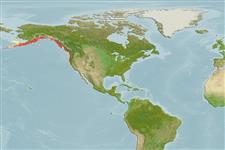>
Osmeriformes (Freshwater smelts) >
Osmeridae (Smelts)
Etymology: thaleichthys: thaleichthys meaning rich fish - referring to a high oil content (Ref. 1998).
More on author: Ayres.
Environment: milieu / climate zone / depth range / distribution range
экология
морской; пресноводный; солоноватоводный донно-пелагический; анадромный (Ref. 51243); пределы глубины ? - 137 m (Ref. 6885). Temperate; 61°N - 38°N (Ref. 26213)
North Pacific: Prince William Sound, Alaska to Monterey Bay, California, USA. Landlocked in Washington and Union Lakes in Washington, USA.
Length at first maturity / Size / Вес / Возраст
Maturity: Lm 9.0 range ? - ? cm
Max length : 20.0 cm TL самец/пол неопределен; (Ref. 27547); common length : 15.0 cm NG самец/пол неопределен; (Ref. 27547); наибольший возраст (опубликованны данные): 3.00 годы (Ref. 12193)
колючие лучи спинного плавника (общее число) : 0; членистые (мягкие) лучи спинного плавника (общее число) : 8 - 10; колючие лучи анального плавника: 0; членистые (мягкие) лучи анального плавника: 15 - 19; позвонки: 55 - 61. Distinguished by its long upper jaw, which reaches at least below the middle of the eye in adults; the fine teeth in a single row on the vomer and palatine bones; and the 38 to 47 gill rakers on the 1st arch (Ref. 27547). Gill rakers long; lateral line incomplete and reaching not quite to below dorsal fin (Ref. 27547). Breeding males have tubercles on upper sides of paired fins (Ref. 27547). Pale olive brown dorsally, silvery white on sides and ventral surfaces; fins usually stripped along the rays, but inter-ray membranes clear;. Young are translucent with 2 rows of large black spots, on each side of the midline of the back, from head to caudal peduncle; peritoneum silver with light speckling. Spawning males with moss-green backs, and dense, black speckling on the head and dorsal surface of the body. The peritoneum is silvery with black speckling.
Found close to shore, in bays and estuaries and ascends coastal streams to spawn (Ref. 5723). There are landlocked populations (Ref. 5723) but these do not reach as great a size as sea-run fish (Ref. 27547). Anadromous (Ref. 96339). Individuals found in brackish and salt water feed on small crustaceans (Ref. 1998). Fish from the sea are reported to have good flavor, but supply is limited (Ref. 6885). Often abundant during the spawning run, but flesh reported to be soft and oily, easily spoiling (Ref. 1998).
Although most individuals die after spawning, some females apparently survive to age 3. It is not known whether or not these 3-year-olds spawned previously (Ref. 27547).
Page, L.M. and B.M. Burr, 1991. A field guide to freshwater fishes of North America north of Mexico. Houghton Mifflin Company, Boston. 432 p. (Ref. 5723)
Статус Красного Списка МСОП (Ref. 130435: Version 2024-1)
Угроза для людей
Harmless
Использование человеком
рыболовство: рыболовство как средство для существования
дополнительная информация
инструменты
Специальные отчеты
Скачать в формате XML
ресурсы в Интернет
Estimates based on models
Preferred temperature (Ref.
123201): 4.4 - 11.6, mean 8.4 °C (based on 196 cells).
Phylogenetic diversity index (Ref.
82804): PD
50 = 0.6250 [Uniqueness, from 0.5 = low to 2.0 = high].
Bayesian length-weight: a=0.00372 (0.00178 - 0.00775), b=3.17 (2.99 - 3.35), in cm total length, based on LWR estimates for this (Sub)family-body shape (Ref.
93245).
Trophic level (Ref.
69278): 3.2 ±0.35 se; based on food items.
Generation time: 2.6 ( na - na) years. Estimated as median ln(3)/K based on 1
growth studies.
устойчивость к внешним воздействиям (Ref.
120179): средний (среднего размера), минимальное время удвоения популяции 1.4-4.4 года (tm=2; tmax=3; K=0.43; Fec=535).
Fishing Vulnerability (Ref.
59153): Low to moderate vulnerability (28 of 100).
